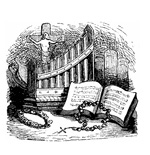
At Mass, Actions Speak Louder Than Words
WHY LITURGICAL LESSONS AREN'T BEING LEARNED
I have taught in Catholic schools for many years. For the past ten, I have had the pleasure of teaching sixth-grade religion classes in a school that is unwaveringly faithful to the Magisterium. The religious curriculum in the sixth grade includes the sacraments, the theology of the Mass, and Church history. In previous grades, the students thoroughly study the faith with the help of textbooks that are faithful to the Church, and teachers who are devout, enthusiastic, and knowledgeable.
Nevertheless, year after year I am surprised by what my students know — and do not know — at the beginning of their sixth-grade year. Students are typically baffled and sometimes even stunned to learn that the Blessed Sacrament is Christ physically present in His body, blood, soul, and divinity, and not just in a spiritual or symbolic sense. More often than not, these students have incorrectly acquired the notion that the Holy Sacrifice of the Mass is just a Communion service memorializing the Last Supper with the priest acting as presider. They are fascinated to learn about the sacrificial aspects of the Mass and the priesthood, and the tremendous graces received from the Mass. Why are all these students, who have no less than five years of solid catechetical training, entering the sixth grade with an almost Protestant view of Catholic liturgy and the sacraments?
One might question the content, quality, and overall effectiveness of the religion program. But after years of observing, monitoring, and, most importantly, probing the students, I have come to a clear assessment of this peculiar situation. Irrespective of what is being taught, if the Mass and liturgies do not reflect the realities and truths of our Catholic faith, the teachings of the Church will be taught in vain. It is of the utmost importance that the Holy Mass model and emphasize what we want our students (and adults) to understand and embrace. The rubrics, gestures, and symbols that are employed serve a fundamental and very useful purpose in that they reveal and give witness to the faith we profess.
To illustrate a common example, I ask students at the beginning of their sixth-grade year what they genuflect toward inside a church. At least ninety percent say the crucifix or the spiritual omnipresence of Christ. After receiving a thorough explanation that genuflection is an act of adoration toward the real presence of Christ in the Blessed Sacrament, the students invariably have a number of questions, a typical one being: “If we believe that the Blessed Sacrament is Christ Himself truly and really present among us, then shouldn’t we show greater respect and reverence at Mass?” The crux of the problem is that students cannot retain the truths they are taught if these truths are not manifested on a regular basis in our liturgical language, songs, gestures, and symbols.
You May Also Enjoy
St. Thomas writes, "It is absurd, and a detestable shame, that we should suffer those traditions to be changed which we have received from the fathers of old."
A black vestment helps induce a sense of penitential recollection -- remembering that "here we do not have a lasting city" (Heb. 13:14).
A number of English bishops, including the Cardinal Archbishop of Westminster, is displeased with Summorum Pontificum.

